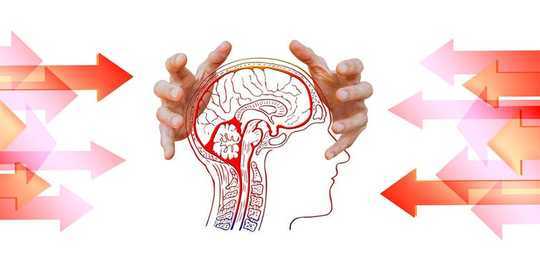 A brisk 30-minute walk three times a week is enough to prevent stress-induced depression. (Shutterstock)
A brisk 30-minute walk three times a week is enough to prevent stress-induced depression. (Shutterstock)
Suffering a quarantine dip in mood? Struggling to find motivation to do anything? You are not alone. Just six weeks of chronic stress can lead to depressive symptoms, even in people without a prior diagnosis. We are past that six-week point in this pandemic and you may be experiencing a depressed mood unlike anything you’ve experienced before.
Our research in the NeuroFit lab at McMaster University shows that exercise can prevent stress-induced depression. A brisk 30-minute walk three times a week is enough. But even under the best circumstances, nearly half of young adults and 70 per cent of older adults find it difficult to be sufficiently active for good health.
Our latest research aims to develop an Exercise Toolkit for Mental Health to support people during this pandemic and in the future. But we need your help. By participating in our survey, you’ll be helping us gather the information we need to provide a toolkit based on the real circumstances that people are coping with during COVID-19.
One stress response for all stressors
An unfortunate side effect of the COVID-19 pandemic is its impact on psychological distress and mental health. Psychological stress, such as a conflict with a family member, activates the stress response in the same way as a physical threat. It all starts in the brain stem with the activation of the hypothalamus and its two parallel axes: the SAM axis (sympathetic adrenal medullary) and the HPA axis (hypothalamic pituitary adrenal).
 The pandemic has brought with it numerous stressors, including health issues, financial issues, relationship issues, isolation and changes in home and work responsibilities. (Pixabay)
The pandemic has brought with it numerous stressors, including health issues, financial issues, relationship issues, isolation and changes in home and work responsibilities. (Pixabay)
The SAM axis works quickly. Through the sympathetic nervous system, it causes a rush of adrenaline into the blood, initiating the “fight or flight” response to unleash the body’s maximum power.
The HPA axis works more gradually. It induces a cascade of hormones that leads to the release of cortisol into the blood, which in turn liberates stored sugars from the liver and fat cells. This provides the body with the energy it needs to endure the stressors over a longer period of time.
In its acute form, stress is actually a good thing because it wakes up your brain and body for action and helps performance. However, in its chronic form, there is greater reactivity and slower recovery of the stress response. That means the stress response is triggered more easily, in response to lower levels of stress, and takes longer to revert to a normal state. The result is major strain to the brain and body that can lead to symptoms of mental and physical illness.
Chronic stress of COVID-19 pandemic
This pandemic is incredibly stressful. The abrupt halt to “life as usual” and the idea that things may never be the same has forced a rapid evolution in our collective self-identity. As a result, many people feel like they’ve lost their place in this world. This adds extra tension to daily life, making us more reactive to seemingly minor events, and this can play a major role in forecasting our future brain health.
Under normal circumstances, people reported nearly a 50 per cent chance of having a stressful day. This number is likely higher while people are under stay-at-home orders. Although everyone feels worse on stressful days, people who have more extreme mood swings between stressful and non-stressful days are at an increased risk of developing depression and anxiety.
How long will this last? No one really knows. Over time, this uncertainty and lack of control can alter our reaction to other stressors. Instead of “fight or flight,” we “freeze,” feeling helpless and lacking motivation. These are symptoms of stress-induced depression.
Cross-training the stress response with exercise
Exercise can help. Even though it’s technically a stressor and activates the stress response in the same way as a psychological stressor, the magnitude of the exercise stress response is acute and controllable by modifying intensity and duration. Like strengthening a muscle, exercise “tones” the stress system so that it can tolerate a higher level of stress with less reaction and faster recovery. This makes us more resilient to all forms of stressors, even the psychological ones brought on by this pandemic.
 The closure of gyms and recreational facilities, and limited access to parks and trails, has made exercise more challenging at a time when we need it most. (Unsplash)
The closure of gyms and recreational facilities, and limited access to parks and trails, has made exercise more challenging at a time when we need it most. (Unsplash)
Research from our lab and others shows that about 30 minutes of moderate-intensity aerobic exercise three times weekly can boost mood, reduce psychological distress and decrease symptoms of depression and anxiety relative to those who are sedentary. When compared to antidepressant drugs, this dose of exercise is equally effective at treating stress-induced mental illness without the potential side effects of medication, such as nausea, fatigue or loss of appetite.
However, the sudden closure of gyms and recreational facilities, the restricted access to public parks and trails and the closure of daycares and schools may make it more difficult for people to be sufficiently active for good health.
We want to know how you are doing. We have launched a survey designed to analyze the current mental health status caused by the pandemic, and pinpoint barriers preventing people from regular physical activity during the pandemic. That information will then be used to create an evidence-based physical activity toolkit, free to the public, by July 2020. For more information or to complete the survey, please visit: neurofitlab.ca/covid-19.html![]()
About The Author
Jennifer J. Heisz, Associate Professor in Kinesiology and Associate Director (Seniors) of the Physical Activity Centre of Excellence, McMaster University and Maryam Marashi, Master's Student, Kinesiology, McMaster University
This article is republished from The Conversation under a Creative Commons license. Read the original article.
Books on Fitness and Exercise from Amazon's Best Sellers list
The Four-Pack Revolution: How You Can Aim Lower, Cheat on Your Diet, and Still Lose Weight and Keep It Off
by Chael Sonnen and Ryan Parsons
The Four-Pack Revolution presents a total-life approach for attaining health and fitness goals without the hard work and suffering.
Click for more info or to order
Bigger Leaner Stronger: The Simple Science of Building the Ultimate Male Body
by Michael Matthews
If you want to build muscle, lose fat, and look great as quickly as possible without steroids, good genetics, or wasting ridiculous amounts of time in the gym and money on supplements, then you want to read this book.
Click for more info or to order
The Women's Health Big Book of Exercises: Four Weeks to a Leaner, Sexier, Healthier You!
by Adam Campbell
The Women's Health Big Book of Exercises is the essential workout guide for anyone who wants a better body. As the most comprehensive collection of exercises ever created, this book is a body-shaping power tool for both beginners and longtime fitness buffs alike.
Click for more info or to order
Bodyweight Strength Training Anatomy
by Bret Contreras
In Bodyweight Strength Training Anatomy, author and renowned trainer Bret Contreras has created the authoritative resource for increasing total-body strength without the need for free weights, fitness machines, or even a gym.
Click for more info or to order
The Men's Health Big Book of Exercises: Four Weeks to a Leaner, Stronger, More Muscular You!
by Adam Campbell
The Men's Health Big Book of Exercises is the essential workout guide for anyone who wants a better body. As the most comprehensive collection of exercises ever created, this book is a body-shaping power tool for both beginners and longtime fitness buffs alike.






















